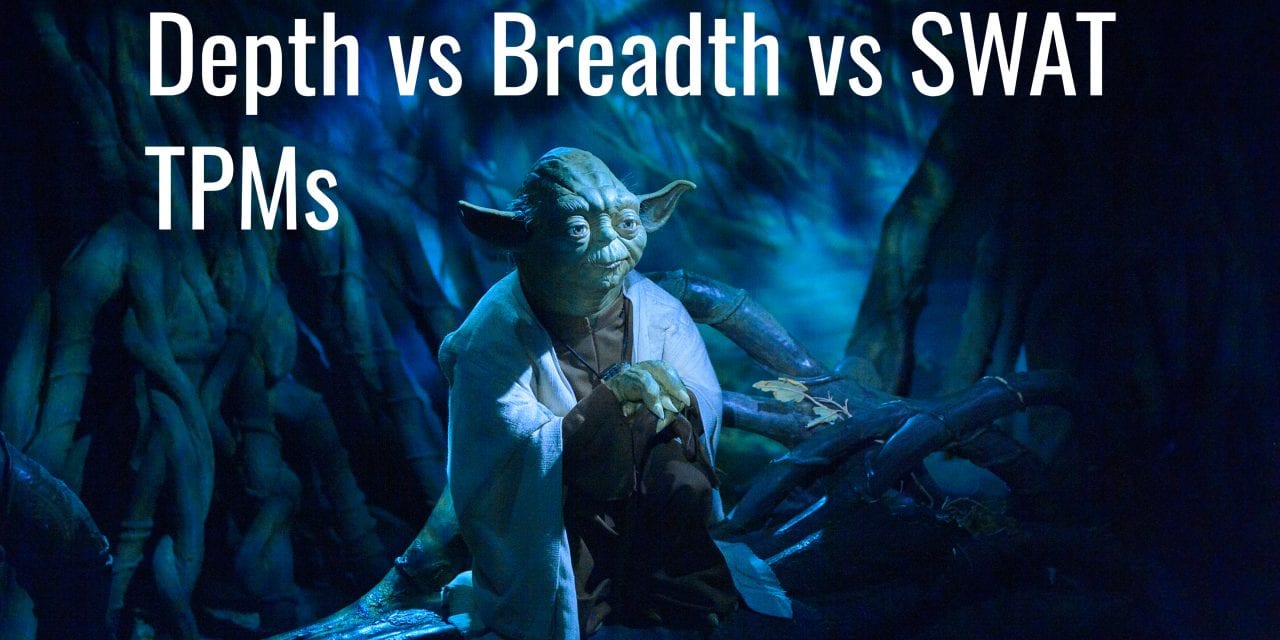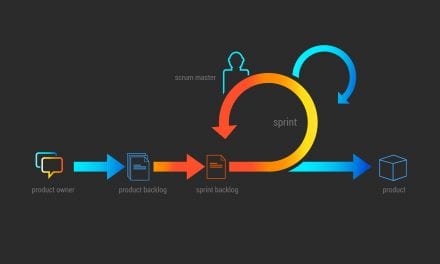Last updated on September 6th, 2024 at 08:56 am
Depth vs Breadth vs SWAT Technical Program Managers. At all my previous roles I have been working as an embedded TPM. I have now been at my current gig for nearly a year where I have been a breath TPM. It’s been an eye-opening experience, on how similar yet different the two roles are. This post is going to go into how we can classify a TPM role into depth vs Breadth and SWAT. We will also go into accessing the kind of skills or competencies one would need to excel at each of them.
Before we move on the Depth vs Breadth vs SWAT TPMs roles, let’s take a quick look at the TPM roles classified by the type of discipline or areas of expertise – you can also for a large degree consider them as examples of depth TPMs.
- Front End: Web, iOS, Android.
- Backend: API, SDK – Platform.
- Integration: PM who works with 3rd parties to integrate their APIs.
- Business Intelligence: Big data, Hadoop, Machine learning, AI, etc.
- ERP: Implementing Oracle EBS, SAP, SalesForce, Microsoft Dynamics, etc.
- Localization: To take existing products/services to international markets.
- Hardware: Chip Manufacturing. VMWare, Nvidia, Intel, etc
- Data Center: With all the cloud stuff happening, there is a dearth for datacenter PMs.
- Process: Lean, Six Sigma, Process optimization, Scrum/Agile Coach, PMO.
- Security: Managing Risk, Governance, Compliance.
- Operations: Stability, Scalability, Monitoring, Disaster Recovery, System Health.
- UX/UI: Specialize in managing UX teams.
- Cloud: Expertise in migrating on-premise applications on to the cloud.
Ps- The above is not an all-inclusive list but you get the idea.
Depth TPMs
If you are a TPM you are likely a Depth TPM. The reason I say that is most TPMs are depth TPMs 🙂 Most TPMs are generally embedded within a development team and are responsible for the delivery of features or feature enhancements they own. An embedded TPM or a Depth TPM owns the feature or the set of features end to end.
They work with product managers to understand the vision of the product and work with the development team to help them implement this vision. Sometimes they wear the hat of a Scrum Master, Architect, Protector. At the end of the day, a Depth TPM is responsible for the delivery and uptime of the team’s microservices.
As a TPM you ensure your team’s morale is high and the services they deploy are high and the work gets done. You are your teams representative and set a high bar of what is expected of your team. You also ensure that your development team is not randomized and you are communicating effectively to both up and downstream teams. i.e teams your team is dependent on and teams who depend on your team’s service.
Depending on the size of your organization, you as a depth TPM might own the entire front end or you might just mobile or just Android as the size of the organization increases your ownership and scope would decrease considering you are at the same level. Which means if you lead a 2 pizza dev team at a smaller startup that might consist of 10 devs, 5 being android and 5 beings iOS; then you would still lead a 2 pizza size dev team in an organization like uber or fb but only that the scope of responsibility that your team has would be a sliver of the entire app.
There you go, I hope that explains what a depth TPMs responsibilities are and hopefully, most of you were already familiar with that 🙂
Breadth TPMs / Uber TPM / Launch TPM
What is a Breadth TPM? A Breath TPM manages a program in the very true sense, think about a TPM who owns launching a product like Kindle or the Apple watch. At the end of the day, there is one person who owns the launch of something like this. At times you might have several levels of Breadth TPMs in the case of something like the Kindle you would have various Breadth TPMs –
- Hardware
- Software
- Go To Market – Pricing, promotions, Press, etc
- Legal
- Content – Getting all the content.
Each of these is fairly big areas and these Breadth TPMs are generally interacting with over 50+ TPMs in their area to reach the final goal. They may even have to interact with teams outside their core areas. Taking the Kindle example and think about how closely the hardware and software team would need to work to make things happen.
In my opinion, the Breadth role is more of graduation of a Depth TPM. In other words, a Breadth TPM needs to have a good exposure or tenure as a Depth TPM. Most Breadth TPMs need to have the technical competence to drive deep when needed. The most competent Breadth TPMs are the ones who are very versatile with their ability to communicate / articulate problems, understand the architectural as well as system level complexities and make the right call on where and what needs to be fixed or accelerated. If one does not have the technical knack or the exposure to the nuts to bolts of things it’s quite hard to excel at being a breath TPM. In fact, I believe that one would fail.
Skills Needed For a Breadth TPM
As I mentioned above the Breadth TPM needs to be very versatile. What does this mean? A Breadth TPM has skills like a swiss army knife. He is pretty well versed in process creation, Operations, Development, Cloud technologies, Navigating political issues, Security etc. The list is endless. Sometimes it’s necessary to know some of these areas when you start with a breath role, but in most cases, you would also see an individual who excels at these roles to be really sharp and have the innate ability to understand deep and complex problems at ease.
Breadth TPMs, in general, have owned, built and navigated programs that were extremely complex, they have battle scars and tonnes of stories to tell. A key thing to remember is that a Breadth TPM owns the program. He is the sole owner, the buck stops with him. It is not a job as a coordinator or a manager. In breadth type of role a TPM works across 50+ teams so many things go wrong, how you steer the ship, nudge it every so often and get it to the finish line as the captain. Yes, breadth TPMs have an immense authority that comes with a responsibility that sits squarely on their shoulders.
A breadth TPM is one area where if you are not doing things right, it becomes apparent quite fast as there are several teams that get impacted by your actions and the direction you give. A breadth TPM sets the rhythm, the cadence, the urgency and ideally has an infectious personality. In most cases you do not have ramp-up time, you do not have the luxury to say well I’m going to take the next month or two to get to understand things.
Scope and Impact of Breadth TPMs
The other thing to keep in mind when you look at various TPM Breadth roles and opportunities is the Scope and Impact that the role has to offer. Scope and impact are closely related.
The scope can be defined as the goal of the program while the impact is the effect the program you run has to the organization.
Scope – Think about launching a service like Uber in a new city. It’s pretty straight forward. This is what you would call the scope of a program.
IMPACT – Impact can be defined as the effect your program would have on the organization as a whole. The impact could be measured with strategic significance or with a monetary benefit.
When you combine the two, high scope and high impact you end up solving some of the most crucial problems your organization is a facing, it becomes a game changer both for the organization and for one’s career.
SWAT TPMs
SWAT stands of (Special Weapons and Tactics) team is a law enforcement unit which uses specialized or military equipment and tactics. See Wikipedia.
This might sound crazy, but almost every organization you know of has a SWAT team, most tech, as well as non-tech companies, do and it’s been around for a long time. SWAT is just one name but they go by, some companies call them the A-Team and others have their own nomenclature.
You can find articles online like this one here. The Oracle’s A-Team’s tag line is “If you have a problem if no one else can help, and if you can find them, maybe you can hire the A-Team”.
You generally do not find a lot of literature on this topic. And there is a reason for that, SWAT, in essence, is covert, they are dropped into a situation when the situation needs help and is of strategic value to the organization. They ALWAYS come in to fix a specific problem and LEAVE when their job is done. They do not take over running a team, an organization, a feature or a release once they have completed their goal. They may, however, put processes in place or give a recommendation on what the team could do to better.
As I mentioned above they are tasked with a very specific objective and in most cases have full authority to make decisions while keeping their leadership informed or always in the loop. SWAT moves fast to identify the issues, problems and get to the root cause eliminate it if necessary and get on to finish their task. I have seen SWAT sometimes come in drive urgency get the fire going and then put the right people in place to get things going and watch from afar as things progress.
A good analogy to what SWAT TPMs do is to take look at the Vincent Wolf character in the movie Pulp Fiction played by Harvey Keitel. He introduces himself as a man who solves problems.
I hope the above clip gives you a view into how SWAT TPMs work.
SWAT generally report to the top executive management personnel and are always given the resources and power to get the job done.
What is the consistency of a SWAT team?
SWAT consists of battle-trained individuals who have a variety of skills. SWAT teams could be a Team of people with different skill sets, they could be developers, architects, TPMs, PMs, etc. Just like the example where a Breadth TPM is alike Swiss Army knife a SWAT team has individuals each with very specific and unique skills.
When a situation arises the leader of the SWAT Team decides what skillsets are required to go address the problem and then decides who gets to take tackle the problem. SWAT owns and operates without ego, sometimes they don’t care too much for a process, check, and balances that have been put in place. They operate with one sole objective to get the job done within reason. 🙂
Ready for your next career adventure?
Get personalized advice from Mario to confidently choose the roles, companies, and skills that shape your future!


















Nice collection with focus on TPM and only TPM roles and how they should be 🙂
– Swat sound more like consulting and breadth sound more like principal or distinguished TPM kind of role. Thanks for sharing
Nice Article
This is a very informative article. Thank you.